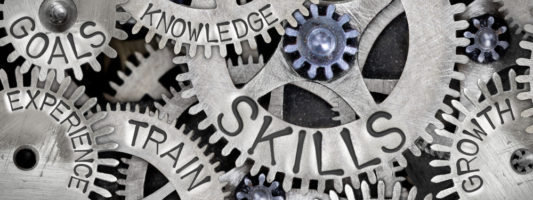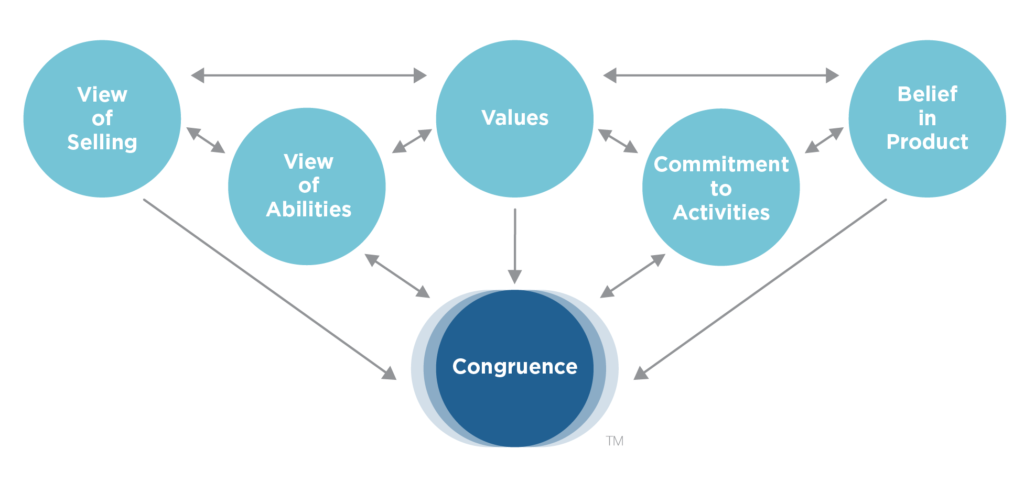A Sales Training Strategies Action Plan to Ignite Your Team’s Success

If you’ve implemented sales training this year, you’re not alone. Studies have shown that upwards of $15 billion is spent annually on sales training in the United States alone. Several thousand dollars per salesperson is spent annually. But the question is, what kind of a return are organizations getting on that huge investment? And are there specific sales training strategies behind that critical investment to help ensure its success and strong ROI?
Salespeople are selling in a much more complex world today, with longer buying cycles, less responsive buyers, a wider range of influential stakeholders involved in the process, and an increasingly well-informed customer base adding to the pressures. The introduction of new technology and tools, combined with a shift away from face-to-face and drop-in visits to tightly planned Zoom meetings, has permanently changed the selling landscape. Most B2B buyers now want to be sold virtually; yet most companies aren’t properly equipping their sales teams to meet these demands. From newbies to old pros, everyone is realizing there’s always more to learn if you want to be able to adapt and succeed in today’s environment.
That means training and development professionals have to make sure they’re up to the challenge and adapting as well. While online training and workshops can be effective delivery mechanisms for information and knowledge, the real impact only comes when you’re able to turn that knowledge into daily behaviors. This requires real, well-thought-out sales training strategies, not just checking a box once a year at a sales kickoff (SKO).
As we’re already into the second half of the year, (and beginning to look ahead to next year) now’s a good time to reevaluate whether your sales training strategies are optimized to deliver the business results your organization (and customers) expect.
4 Questions to Assess Your Sales Training Strategies
First, let’s take a look at a few sales training strategy questions to help you gauge where you are and where you might need to make some adjustments moving forward.
Is our training focused on the key sales success drivers?
It’s a good bet that your training encompasses things like selling skills, product knowledge and the ability to have effective conversations with customers. Keep in mind, though, as the sales environment has changed and the buying process has evolved, so have customer expectations. That means salespeople need to be able to ask good questions and, most importantly, listen to uncover needs and understand the value that matters most to different stakeholders. This takes careful research and planning as well as skill and confidence.
Beyond selling skills and product knowledge, however, is another, more influential driver of sales success, and it’s one that many organizations completely overlook. The reality is, no matter how knowledgeable a salesperson is, it won’t make much difference if they have negative views of selling, aren’t motivated and committed to the activities they need to perform or don’t fully believe in the product.
In fact, our research has found that achievement drive, self-belief and attitude play a much more consequential role in someone’s selling success. What’s more, the companies that focus on these factors in their training enjoy up to 20% more in sales performance.
The interesting part of all of this is that the vast majority of sales leaders agree that achievement drive is what separates their top performers from the rest of the pack. What they don’t always recognize is that it’s something that can be developed through effective training and coaching.
Have we done an alignment check?
To unleash achievement drive, you first have to understand what those underlying attitudes and beliefs are and, just like with a vehicle tune-up, get them in alignment for top performance. In sales terms, this involves assessing whether your salespeople’s knowledge, skills and values are congruent to release the motivation and energy necessary to reach their unlimited sales potential.
If the year has been going slow thus far, you may need to discuss a salesperson’s view of his or her abilities. A negative view can become self-perpetuating, putting the person at risk of falling further behind. If the processes are in place but people aren’t following them, there may be a lack of commitment to the activities necessary to achieve quota. As you review progress toward goals, focus in on the degree to which the person is engaging in the activities and where there might be gaps. Together, you may discover some quick remedies that will make the salesperson more efficient and help accelerate the sales cycle.
A salesperson’s view of selling will also have an impact on their effectiveness. If they view selling as a mutual exchange of value rather than a high-pressure or manipulative “product push,” they’ll not only be rewarded for it, they’ll be more energized by the process.

Congruence gaps can cause conflict and stress, and they’re often the root cause of stifled productivity. These and other alignment checks should be part of the ongoing performance strategies of the sales manager and coach.
Are our sales managers building the bridge?
On that note, if managers don’t understand, believe in, model and coach to the skills, your training efforts are largely going to be wasted. Managers have to know the concepts, believe their people will benefit and provide supportive coaching.
This isn’t news, of course. In a sales coaching study we conducted, 76% of the respondents said they consider coaching important. Here’s the baffling part: In that very same study, 76% also said they believe too little (and sometimes no) coaching is provided!
When we probed further, we learned that, by and large, coaching is not well understood by the managers who are supposed to be providing it, poorly supported and modeled by senior leadership and not really valued for the impact it creates. As a result, many sales managers end up thinking they’re coaching when they’re not, or deciding they “don’t have time” to coach when they’re really not confident in their ability or clear about what it is.
In healthy coaching cultures:
- There is a shared, agreed-upon definition of what coaching is and what the coaching relationship entails.
- Senior leaders prioritize coaching and expect others to coach their teams.
- Sales leaders help their teams develop goals that are meaningful to them
- Managers receive coaching, training and tools to coach their teams effectively.
- Managers believe in the importance of coaching — they have the “will and skill” to lead — and they believe that their people have the ability to achieve big things.
Coaching and reinforcement aren’t just for those who may be struggling. Just as top athletes rely on great coaches, your top performers need the structured coaching to keep pushing to new levels of success. Effective coaching reinforces a belief system—the attitudes, motivations, beliefs and values—that creates their drive for achievement and multiplies their sales power.
Do we have a structured follow-up plan in place?
We assume that if we teach skills in a workshop or an online course, sales representatives will remember and practice them. But study after study tells us that, without reinforcement, most people forget nearly all of what they’ve heard and quickly go back to old habits.
Make sure your structured follow-up process includes:
- Accountability for real-world application
- Repetition and time lapse
- Feedback on progress
- Positive reinforcement and supportive coaching
Ongoing reinforcement and coaching are essential, not just for keeping skills and knowledge sharp but also for adjusting approaches and strategies as conditions change.
There also has to be commitment at all levels to the follow-up process. Many organizations start out with good intentions but gradually slide as things get busy. Reinforcement is too important—to the success of the training programs, the sales professional and the company—to go by the wayside.
Especially if salespeople are struggling to hit their numbers, look at what reinforcement you’re currently offering and what additional performance support tools might help. New technology options provide you with so many more innovative and engaging ways to you refresh skills and enable broader adoption of processes.
3 Action Steps for Salespeople
In many ways, salespeople are like the CEOs of their own business, and by developing a mindset of ownership, they can take control over their success and their futures. But they don’t always know where to start. Here are a few action steps to help salespeople get the most from their learning and development and build up positive momentum for the rest of the year and going forward.
Keep, stop, start
If you look take a look back over the year so far, you’ll see some patterns. What’s been particularly effective? Where are you getting the best return on your energy, effort and time investment? Where do you keep running up against a wall? Are there certain activities you’re avoiding? Is there something else you could be doing that would add more value?
To make the most of the remainder of the year, consider creating a “keep doing, stop doing, start doing” list to re-calibrate your thinking and adjust your priorities. As you write this list, keep these principles in mind:
Just because you’ve always done something a certain way isn’t a good reason to keep doing it. Make sure that it’s really adding value. There is often an opportunity cost (“if I do this, I won’t have time for that”) that needs consideration. At the same time, some activities take time to build momentum and gain traction. If you stop too soon or don’t put the full effort behind it, you could be shooting yourself in the foot.
Finally, if you’re struggling to come up with ideas for your “start doing” category, think about the performance tools, systems and skills you’ve acquired or have access to. Are you really using them? How might you apply them to your current challenges?
Get in shape
Remember that training program you went through a while back? How you came back with a new mindset, energized and ready to apply your new skills and tools?
If it’s been a while, the attention and enthusiasm may have worn off. That’s only natural. In fact, most people go back to old habits and routines if they’re not consciously reinforcing and applying new skills and knowledge. According to the concept of the “forgetting curve,” people tend to lose up to 70% of newly learned knowledge in a matter of days or weeks if they don’t regularly review it.
Just like your muscles need regular exercise to stay in shape, so does your brain. Schedule in time on your calendar to review your processes and practice your skills. Collaborate with a peer on your team. Otherwise, it won’t be a priority. Think of yourself as an athlete: regular conditioning, practice and coaching are essential to elevating and staying at the top of your game.
Focus on the customer
Sometimes we become so focused on meeting quotas, we forget one of the key principles of selling with integrity: Selling isn’t something you do to people; it’s something you do for and with them. Selling with integrity is about identifying and satisfying customer needs and creating value for them, not trying to sell them something they don’t need.
If you’re having trouble breaking through or meeting your goals, consider whether you need to pivot your focus away from your objectives, products and services and toward gaining a better understanding of the customer’s stated and unstated needs. No matter how much enthusiasm you show for your products or services, if you aren’t asking the right questions early in the sales discovery process, your chances of gaining trust and rapport with that customer and ultimately making the sale are slim. The more you try to understand someone’s wants and needs, their fears and drivers, the more interested they will become in hearing what you have to say and buying from you.
The paradox is that people don’t want to be sold to these days, but they do want to buy! Rather than spending time on techniques that attempt to persuade someone to buy something, work on establishing loyal customer relationships based on creating value.
Integrating Sales Training Strategies into the Culture
We talked above about the importance of follow-up and reinforcement, but for the concepts to become part of a salesperson’s day-to-day business behavior, they also have to be hard-wired into the culture. Here are some places where integration is key:
- Competencies
- Field ride or video conference evaluations
- Performance appraisals
- Coaching support tools
- Other training and communication
Do a quick check of your business and performance systems to make sure they’re aligned with the desired behaviors. You might discover some weak spots that could be contributing to performance lapses or a breakdown in process and skill application.
Now is also a good time to consider whether your managers need training themselves to learn how to not only role model the desired behaviors but also be able to coach their people as they practice the skills. Effective coaching is critical for creating the willingness to practice the skills and a drive to achieve greater sales potential, even when dealing with the ups and downs of a challenging selling environment.
With longer sales cycles, more sprawling buyer groups, a glut of technology and data, and questions remaining about the shape of the economy, your salespeople are likely feeling the heat right now. You can’t control many of those variables, but you can take steps to shore up your sales training strategies and coaching competencies to put them and the organization on strong footing for the rest of this year—and for the future.

Chief Marketing Officer
Related Blog Posts



